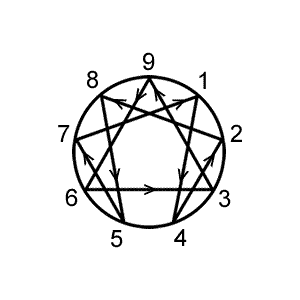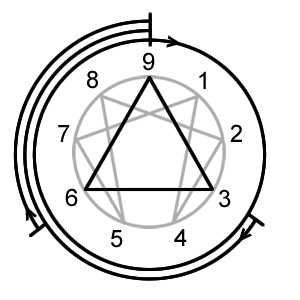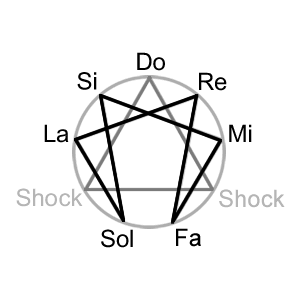The Gurdjieff Enneagram: Fourth Way use of the Enneagram symbol

While the Enneagram symbol or diagram was introduced in the teachings of G.I. Gurdjieff and the Fourth Way, today's personality types were never a part of those teachings.
G.I. Gurdjieff and the Enneagram
Gurdjieff purportedly learned of the Enneagram symbol or diagram from a Sufi brotherhood called the Sarmoung during his travels in search of hidden knowledge.
These travels were depicted in the movie Meetings with Remarkable Men.
One scene from the movie depicts the Enneagram and related movements or dances. The inner lines or hexad of the symbol can be seen drawn on the floor with the three forces of affirming, denying, and reconciling repeated in the background.
Gurdjieff first introduced the Enneagram to his study groups in 1916, but he didn't use it with personality types.
The Fourth Way
Gurdjieff spoke of three traditional pathways of spiritual practice: through the body (the way of the Fakir), the heart (the way of the Monk), and the mind (the way of the Yogi). Gurdjieff taught that a fourth way combines the three centers of these traditional approaches to produce a more efficient, effective, and balanced approach for "waking up". The Gurdjieff teachings are also referred to as the Fourth Way teachings.
The centers of intelligence are an important part of the personality types and map directly to the centers described in the Fourth Way. However, this doesn't mean the personality types came from the Fourth Way teachings. The idea of three centers can be found in many other traditions, theories, and disciplines as well.
The Enneagram as Process
Gurdjieff and the Fourth Way used the Enneagram symbol in a very different way than today's personality types. It was primarily used to understand processes.
Steps and influences in the process were placed on the numbers.

The process begins at point 9, proceeds clockwise around the circle, and ends or repeats when point 9 is reached again. Along the way additional influences or shock points at 3 and 6 are needed to push the process on to the next steps (the shock point at 3 pushes the process on from step 2 to step 4 and the shock point at 6 pushes the process on from step 5 to step 7).
The Laws of 7 and 3
Unlike the Enneagram personality types, not all the lines of the symbol had the same meaning with the Fourth Way Enneagram. The hexad (the lines connecting points 1, 2, 4, 5, 7, and 8) represented the law of 7 and the triangle (the lines connecting points 3, 6, and 9) represented the law of 3.
The law of 7 was sometimes called the law of octaves because a musical octave was placed on the symbol to better illustrate the law of 7.

The octave begins at Do (point 9) and proceeds clockwise up the musical scale to Do an octave above (point 9 again).
The law of 3 can be seen at the triangle points where point 9 indicates the start and end of the scale at Do and the shock points at 3 and 6 push the process along.
Gurdjieff and the Enneagram personality types
Some teachers of the Enneagram personality types attempt to correlate the Gurdjieff or Fourth Way teachings with the Enneagram types. It's important to note that Gurdjieff had nothing to do with today's personality types. Any correlations made are long after the fact and a result of speculation.
Likewise, some teachers try to apply Gurdjieff's use of the Enneagram symbol to the types. As has been shown, Gurdjieff used the symbol in a very different way than the personality types. Any attempt to apply the law of 7, the law of 3, the Enneagram as process, etc. is simply the interpretation of the person trying to do so and can lead to unneccessary confusion and complications when trying to understand the personality types.
Click here for the Complete Guide to the Enneagram.
This free guide explains- the nine Enneagram personality types
- the many type variations within type
- where the types came from (origins and history)
- how the types use the Enneagram symbol
Click here for Enneagram tests.
These free tests help you find your- primary type
- candidate types
- preferred wing
- intinctual subtype
- instinctual variant stacking
- center types (gut, heart, and head)
- tri-center with wings